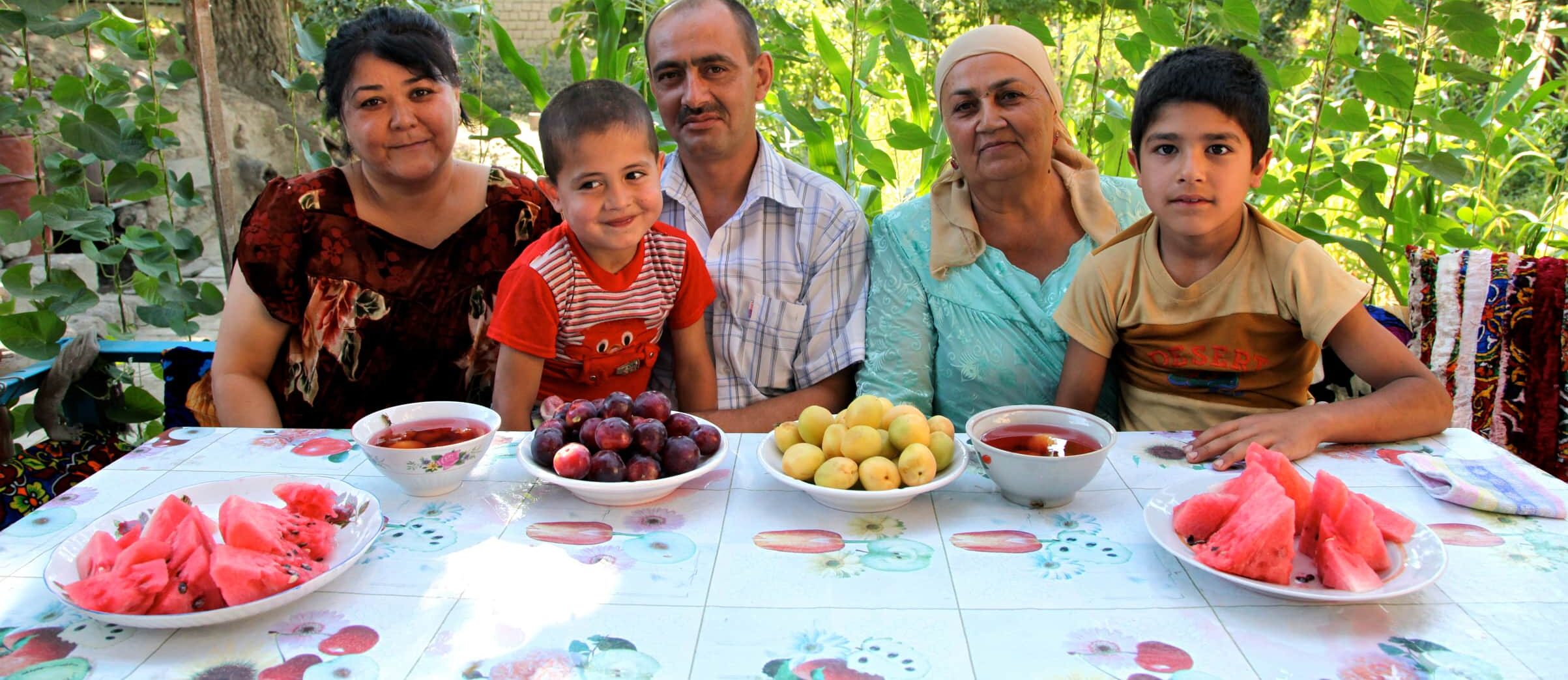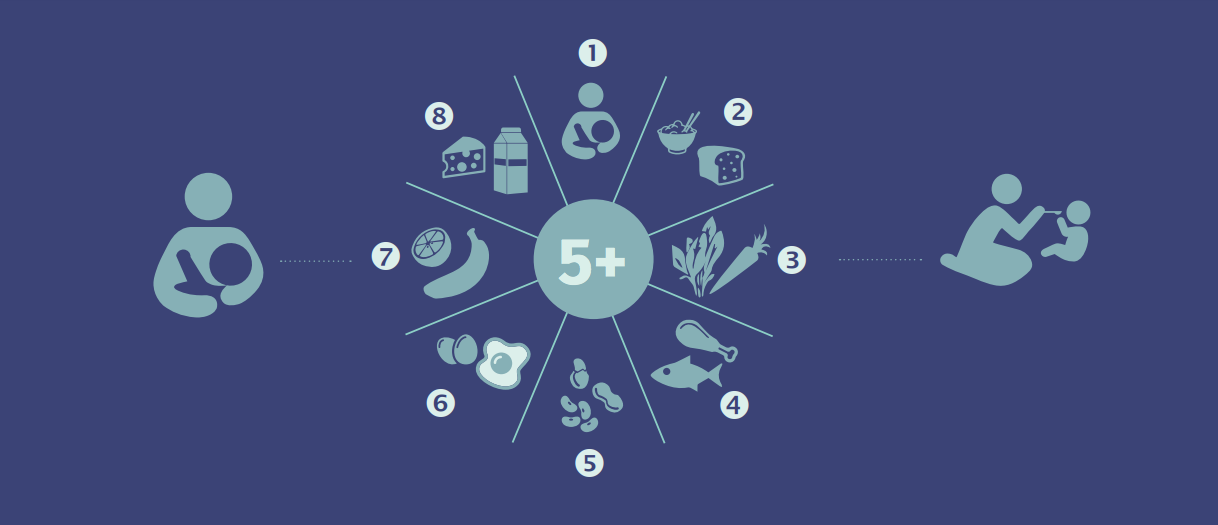Diets

Too many children are not eating the nutrient-rich foods they need to grow and develop
As infants grow, their nutrient needs change rapidly. At 6 months of age, it is recommended that children should begin eating their first solid foods while continuing to breastfeed until age 2 years or longer to ensure that their nutrient intake is sufficient to fuel their developing brains and bodies. In fact, the nutritional needs for growth and development in children 6–23 months of age are greater per kilogram of body weight than at any other time in life. Therefore, frequent feeding of a variety of foods is important to help ensure nutrient needs are met. However, data show that worldwide, most children aged 6–23 months were not fed according to global recommendations.
Far too many children are not fed at the right time or with the right frequency and dietary diversity needed to grow and develop to their full potential. In 2020, one in four children aged 6–8 months (27 per cent) were not fed any solid, semi-solid or soft food – the indicator referred to as introduction of solid, semi-solid or soft foods. One in two children aged 6–23 months (48 per cent) were not fed the minimum number of meals or snacks recommended each day – the indicator referred to as minimum meal frequency. More than two in three children aged 6–23 months (71 per cent) were not fed foods from at least five of the eight recommended food groups – the indicator referred to as minimum dietary diversity. Despite the recommendation that children aged 6–23 months be fed eggs, fish or meat on a daily basis, more than half of children (55 per cent) did not consume any of these nutrient-rich foods during the previous day – the indicator referred to as egg and/ or flesh food consumption. And unfortunately, the quality of young children’s diets has remained persistently poor throughout the last decade.
Globally, the percentage of children aged 6–8 months introduced to solid foods increased from 66 per cent in 2010 to 72 per cent in 2020. Meanwhile, the percentage of children aged 6–23 months fed with the minimum meal frequency has barely improved in the last decade: 51 per cent in 2010 and 54 per cent in 2020. Similarly, the percentage of children consuming a minimally diverse diet – a key indicator of diet quality – has remained low over the past decade: 21 per cent in 2010 and 24 per cent 2020. Children’s consumption of nutritious foods has also increased only marginally over the past 10 years. The percentage of children aged 6–23 months consuming eggs, fish and/or meat during the previous day was 32 per cent in 2010 and 36 per cent in 2020.
Data show that poor diets are not affecting all children equally and across regions. The quality of diets varies by a child’s place of residence and household wealth. Consistently across all regions, children living in urban areas or wealthier households have better diets compared to their peers residing in rural areas or poorer households. And these disparities in young children’s diets have remained unchanged over time.
Disparities between poorer and wealthier households have remained the same with respect to minimum dietary diversity and widened for minimum meal frequency over the past decade.
The 2021 edition of the indicator guidance recommends reporting on three indicators about unhealthy feeding practices:
- zero vegetable or fruit consumption
- sweet beverage consumption
- consumption of unhealthy foods such as cookies, candies, chips and french fries.
Currently data are only available for only one of these three indicators, but this is expected to change in the coming years.
The data show that nutrient rich fruits and vegetables, are lacking from the diets of too many young children. Globally, about half of all children aged 6–23 months did not consume fruits or vegetables during the previous day. Less than 30 per cent of children in East Asia and the Pacific and Latin America and the Caribbean did not consume fruits or vegetables compared to over one half of children in South Asia.
Diets
Resources





Notes on the Data
The indicators
The standard indicators for infant and young child feeding practices developed in alignment with WHO’s Guiding Principles on feeding the breastfed and non-breastfed child are used to assess these practices within and across countries and to evaluate progress in this programme area. The 2021 publication, Indicators for assessing infant and young child feeding practices includes a total of 17 recommended indicators.
This set of indicators provides an update to i) 2008 guide which covered indicator definitions and ii) 2010 guide which covered operational instructions. This edition no longer makes a distinction between core and optional indicators.
Indicators for infant and young child feeding practices
| Indicator name | Definition | |
| Numerator | Denominator | |
| Introduction of solid, semi-solid or soft foods | Infants 6–8 months of age who consumed solid, semi-solid and soft foods during the previous day | Infants 6–8 months of age |
| Minimum dietary diversity | Children 6–23 months of age who received foods from ≥ 5 out of 8 food groups during the previous day | Children 6–23 months of age |
| Minimum meal frequency | Breastfed children 6–23 months of age who received solid, semi-solid and soft foods the minimum number of times or more during the previous day | Breastfed children 6–23 months of age |
| Non-breastfed children 6–23 months of age who received solid, semi-solid and soft foods or milk feeds the minimum number of times or more during the previous day | Non-breastfed children 6–23 months of age | |
| Minimum milk feeding frequency for non-breastfed children | Non-breastfed children 6–23 months of age who consumed at least two milk feeds during the previous day | Non-breastfed children 6–23 months of age |
| Minimum acceptable diet | Breastfed children 6–23 months of age who had at least the minimum dietary diversity and the minimum meal frequency during the previous day | Breastfed children 6–23 months of age |
| Non-breastfed children 6–23 months of age who received at least two milk feedings and had at least the minimum dietary diversity not including milk feeds and the minimum meal frequency during the previous day | Non-breastfed children 6–23 months of age | |
| Egg and/or flesh food consumption | Children 6–23 months of age who consumed egg and/or flesh food during the previous day | Children 6–23 months of age |
| Sweet beverage consumption | Children 6–23 months of age who consumed a sweet beverage during the previous day | Children 6–23 months of age |
| Unhealthy food consumption | Children 6–23 months of age who consumed selected sentinel unhealthy foods during the previous day | Children 6–23 months of age |
| Zero vegetable or fruit consumption | Children 6–23 months of age who did not consume any vegetables or fruits during the previous day | Children 6–23 months of age |
| Bottle feeding | Children 0–23 months of age who were fed from a bottle with a nipple during the previous day | Children 0–23 months of age |
Data collection and reporting
Data for these indicators are collected through household surveys such as DHS, MICS and other national nutrition surveys. With the exception of 3 indicators; ever breastfed, early initiation of breastfeeding and exclusively breastfed for the first 2 days after birth, the other indicators are based on questions about liquid and food intake of children aged 0–23 months in the 24 hours preceding the survey. Standard questions and other practical methodological instructions for collecting, analyzing and reporting this data are also available in this document.